People
10 Great Artists to See at the SITE Santa Fe Biennial
Here, 10 participants discuss their contributions.
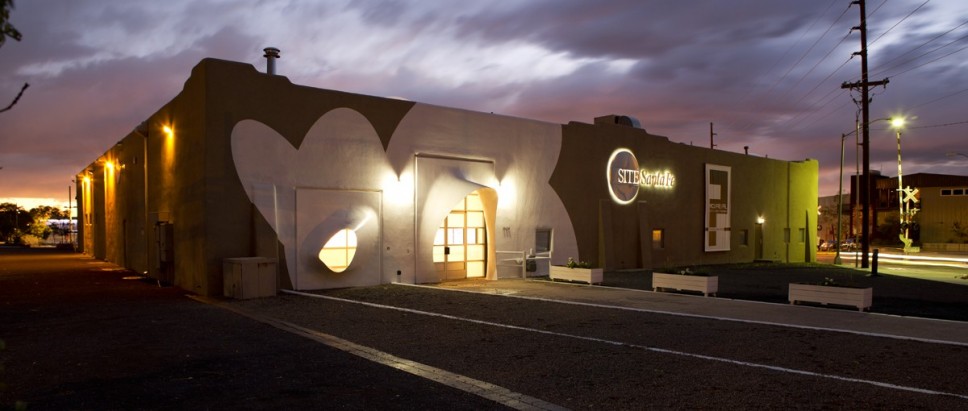
Here, 10 participants discuss their contributions.

Ben Davis

This weekend, SITE Santa Fe throws open the doors to its 2016 biennial, “Much Wider Than a Line.” The product of the combined vision of five curators (Rocío Aranda-Alvarado, Kathleen Ash-Milby, Pip Day, Pablo León de la Barra, and Kiki Mazzucchelli), the show offers plenty to reflect on. But that takes, well, time for reflection; a review is forthcoming. In the meantime, below, 10 of the show’s 35 artists describe their contributions.
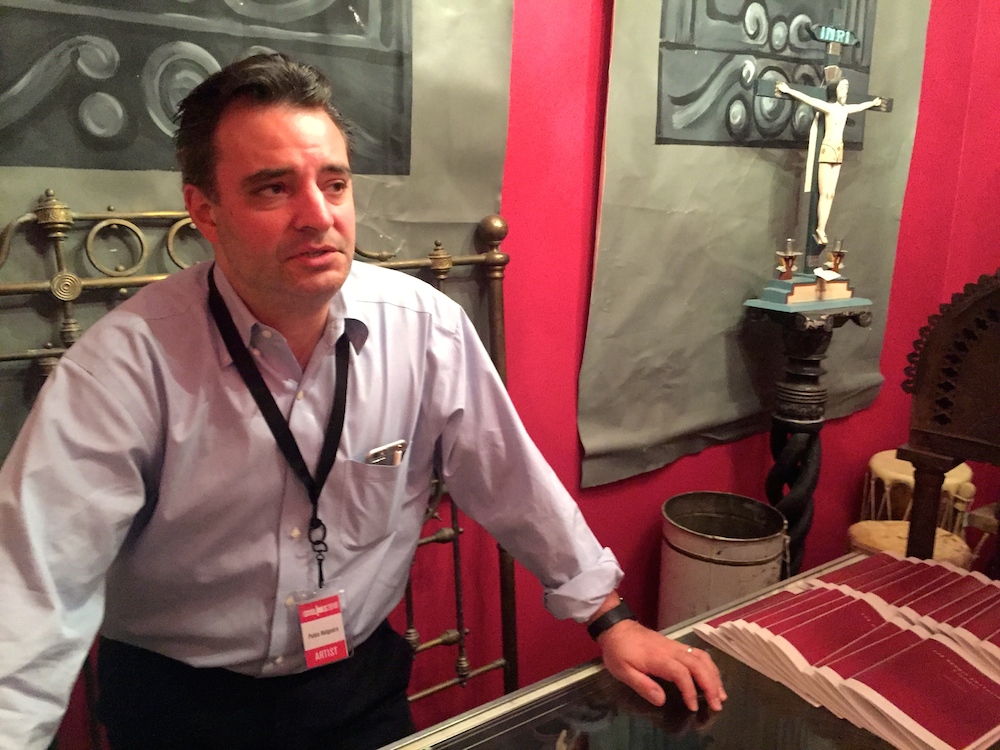
Pablo Helguera. Image: Ben Davis.
1. Pablo Helguera on the installation from his SITE Center artist-in-residence biennial commission
“I’ve spent four years developing a project, the first part of which was presented at the last SITElines biennial. This is the final version. It’s a functioning little shop. You can go in there and actually buy things. I’m interested in history and I’m interested in performance. Being from Mexico, and being in Santa Fe, I think about how history is performed and interpreted. This store essentially sells objects from a play that is fictional, and will never be performed, though you can read the synopses here. It addresses the Pueblo Revolt [in which the indigenous people rose up against Spanish colonizers in 1680], and the way that over the history of New Mexico, it has been cleaned up, so that the relationship between the Native people and the colonizers has been softened by how it is celebrated.”
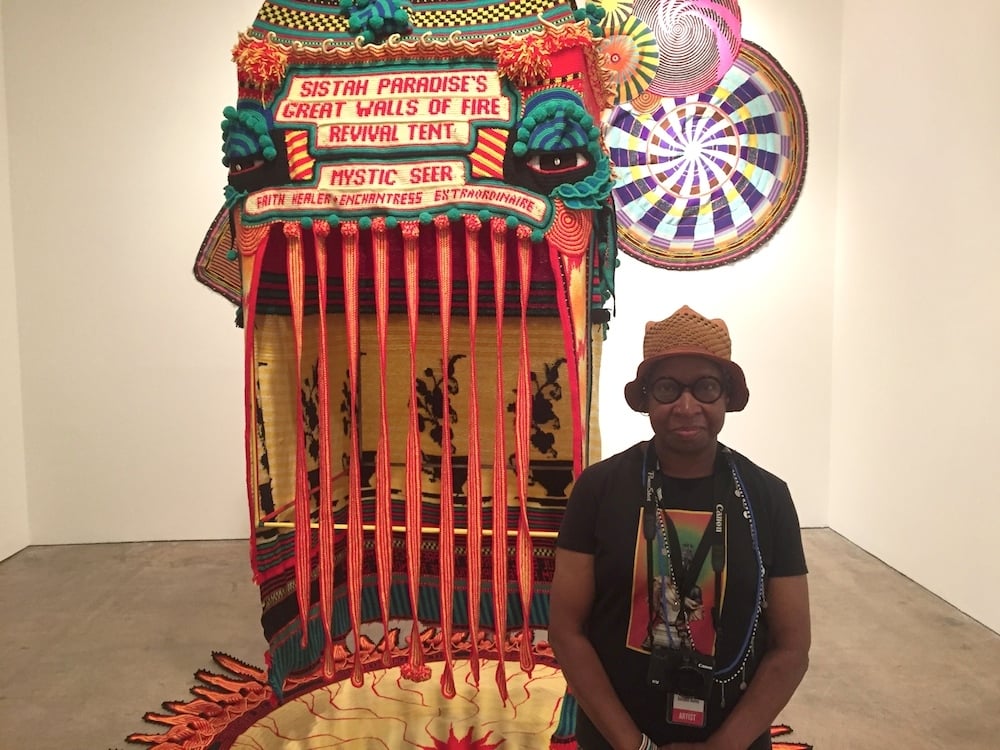
Xenobia Bailey. Image: Ben Davis.
2. Xenobia Bailey on Sistah Paradise’s Great Wall of Fire Revival Tent
“My mother and the community of African-American women that I came from, they were all domestic workers. My mother took care of four homes, including our home. She was a powerful homemaker. But when you study design, you don’t study anything that was done to sustain a household. My mother didn’t have anything; she would remix or make what we had from nothing. This work started out from my time as an artist-in-residence at the Studio Museum in Harlem. It’s a meditation on the African-American homemaker. The first thing I could think to do was to crochet a house. This isn’t the final piece. The final piece will really start this fall, because I am doing a design class at the Harlem School for the Arts on ‘Functional Design’—spelling ‘functional’ with a K.”
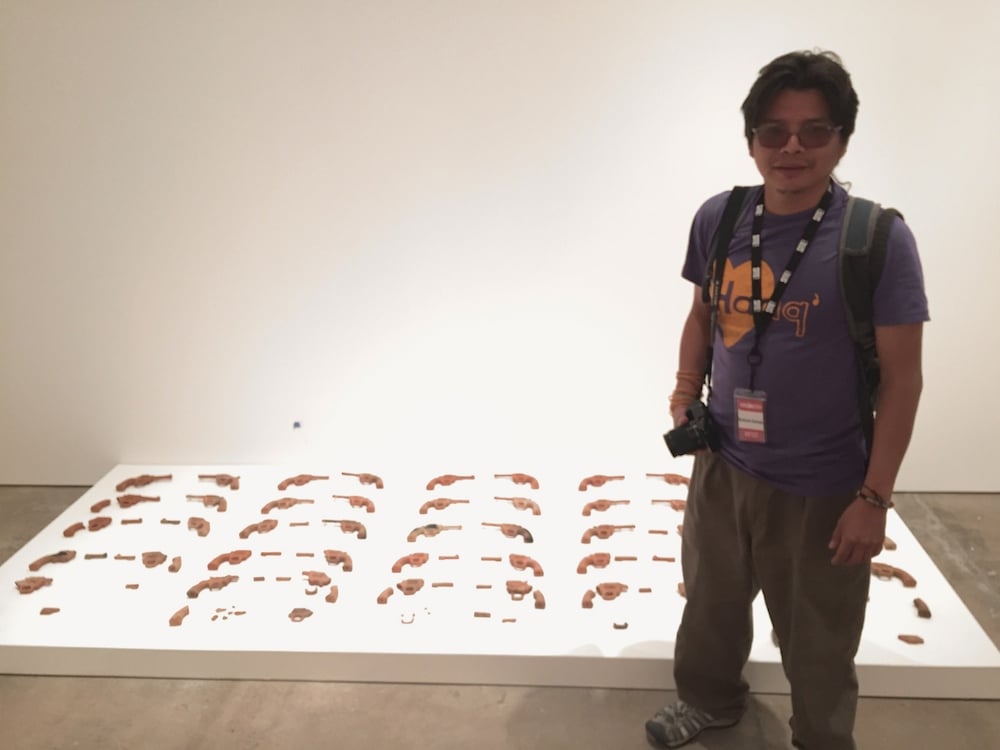
Benvenuto Chavajay. Image: Ben Davis.
3. Benvenuto Chavajay on En Guatemala hay pueblos tan pequeños que caba en la mira de un fusil (2014)
“I’m from a town in Guatemala called San Pedro La Laguna, on the shores of lake Atitlán, 200 kilometers from the capital city. For me, this work is important because the United States has given or sold weapons to our country. What I am doing is bringing the weapons back, but in the form of art. We have a poem in Guatemala that says, ‘There are towns so small that they fit in the crosshairs of a gun’ (‘Hay pueblos tan pequeños que caba en la mira de un fusil’). That’s the meaning of the work.”
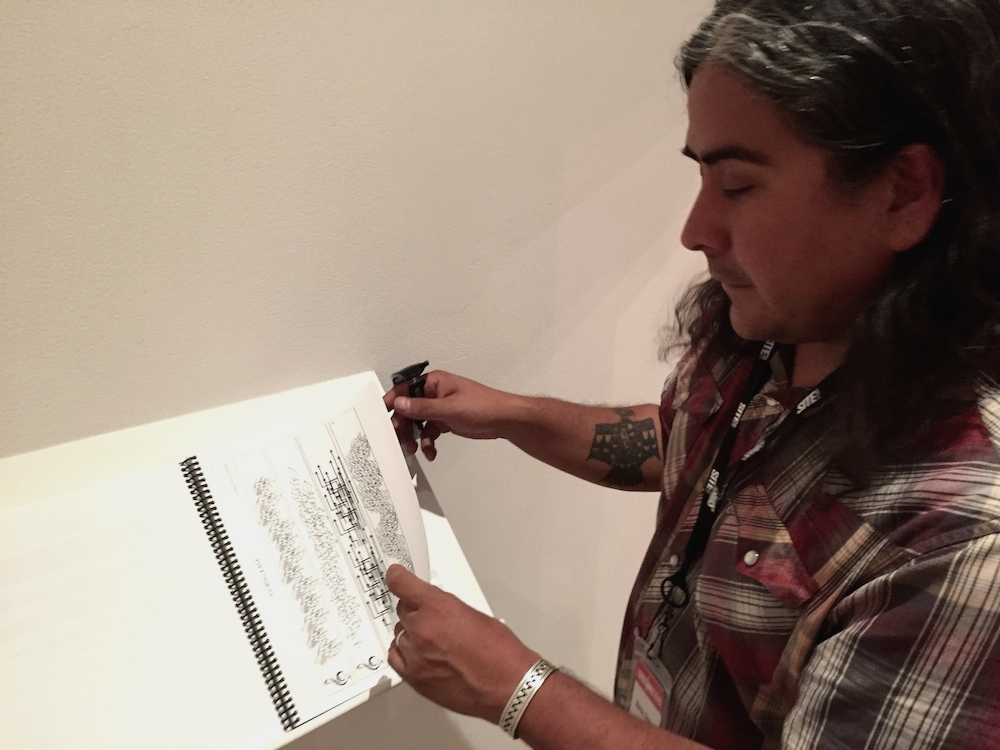
Raven Chacon. Image: Ben Davis.
4. Raven Chacon on the “Native American Composers Apprentice Project” (presented as scores and audio)
“I have been doing this program for 12 years where I go out to the Navajo, Hopi, and Salt River Pima reservations—I’m from the Navajo reservation—to seven different schools now. I talk to the music teacher, or sometimes it’s the art teacher, or the school principal, and find five kids who want to write a string quartet. Sometimes these kids are really smart; sometimes the principal will say, ‘This kid is a genius, but he plays his guitar in math class. He’s a bad student.’ I still say, yes, let’s do it. I have them write a three-minute string quartet. This is what these are, these scores. Some of these students, if they are fortunate, they’ll have a piano or a band at school, and then they’ll know how to read music. But there are students who are more artists than musicians, and I’ll let them do something like graphic notation. Look at this one: She knew everything, what every symbol meant. It’s very well thought out. On Labor Day weekend, all of the students go out to the Grand Canyon. They see people come out from all over the world, and world-class musicians put on their concert.”

Lewis deSoto. Image: Ben Davis.
5. Lewis deSoto on his “Empire” series (2013-2014)
“This whole thing is part of a book project I did. The alternative name I had for it was ‘All the Names of Paradise,’ because there’s an overlapping series of evidence that you can see in the picture that has to do with the relationships to Native folks, to the Spanish, to the Americans who moved in, to contemporary society. That explains the book, the overlapping of these worlds. For instance, the foreground mountain, which is all ground down, was the Hill of the Ravens, and then the Lonely Mountain, and then it was called Mount Slover. So we’re talking about the renaming of the world for people, against the notion of the spirits that are existing.”

Sonya Kelliher-Combs. Image: Ben Davis.
6. Sonya Kelliher-Combs on “Remnant” series (2016)
“I collect anything that is beautiful. Sometimes it happens to be an animal part or a beautiful braid or any number of these things. All of the objects in these pieces are sourced from Alaska. I collected them throughout the years, and I knew I wanted to do something with them. And this idea of encasing them in a synthetic medium, basically pure plastic, a polymer, reflects the way we are treating our planet. Everyone is talking about ’nature and man.’ Well, man is nature. Man is part of nature. Something that is important to me is not having a distinction between one and the other. Because ultimately we depend on each other.”
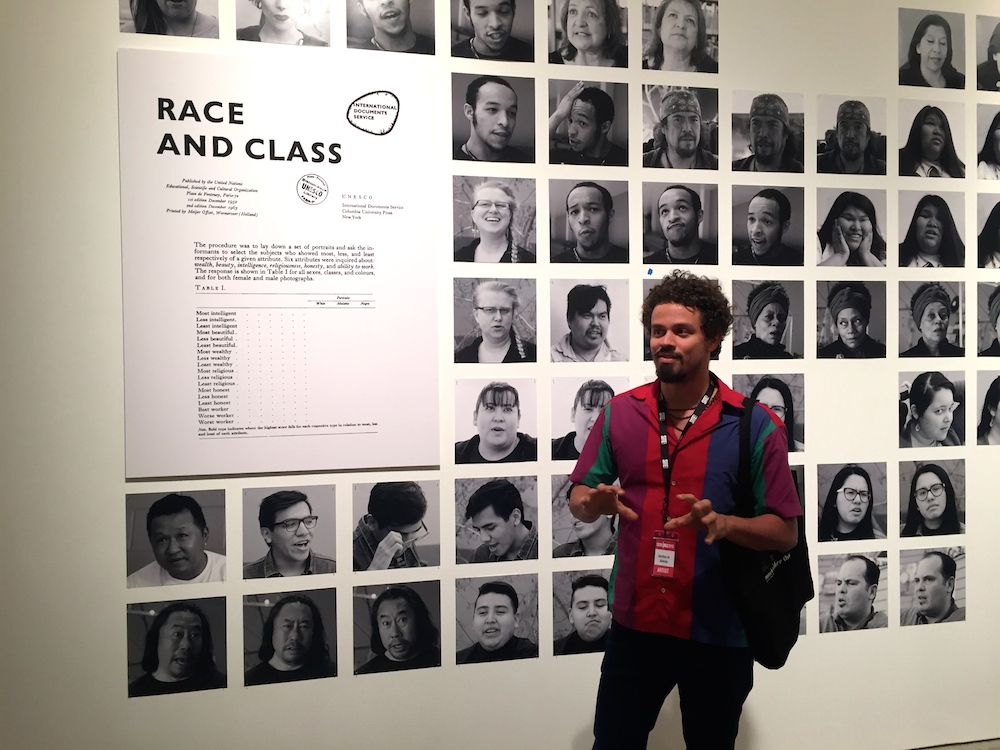
Jonathas de Andrade. Image: Ben Davis.
7. Jonathas de Andrade on his A Study of Race and Class: Bahia><Santa Fe (2015–2016)
“These pictures were taken in February here in Santa Fe. I talked to people in schools, on the streets, people waiting for jobs in the square. I had imagined that here in New Mexico, the conversation on race and racism would be more intense. I could feel that the experiences of these things were daily. You can read some of their stories in the yellow booklet here. [The project] has made my own views of American culture more complex.”
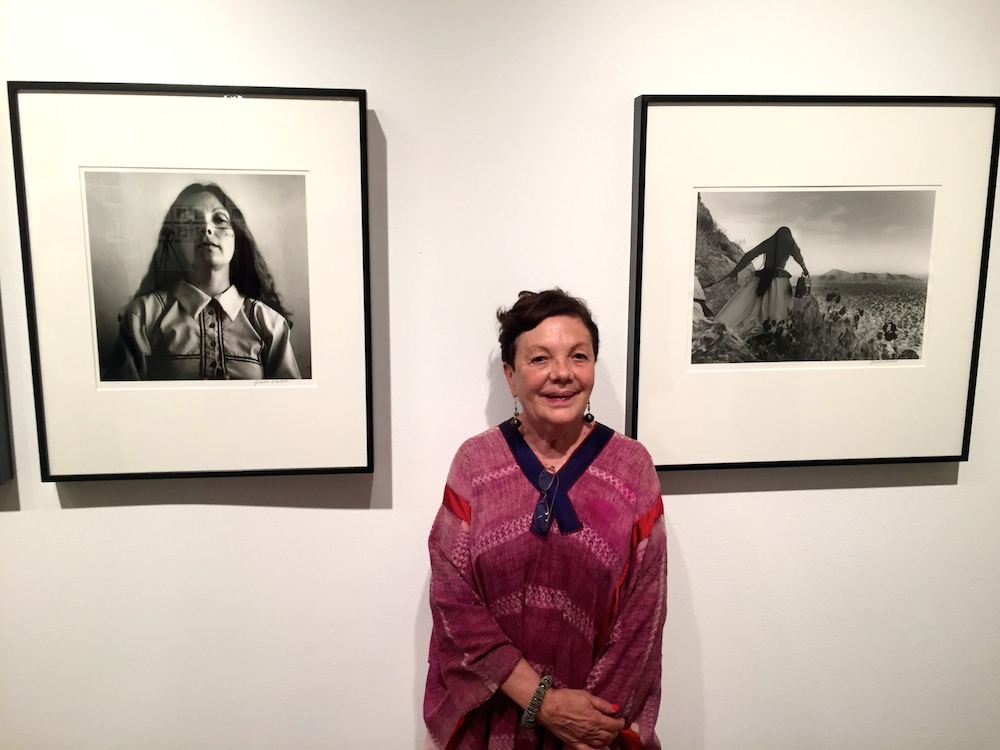
Graciela Iturbide. Image: Ben Davis.
8. Graciela Iturbide on Mujer Ángel (1979) [at right]
“They lived near Arizona. They lived in Sonora, in the Sonora desert. They would trade their handicrafts for these tape decks, and would listen to music, American or Mexican, in the desert, all the day. One hundred years ago, they were nomads. Then all of a sudden they had to change from nomadism to capitalism.”
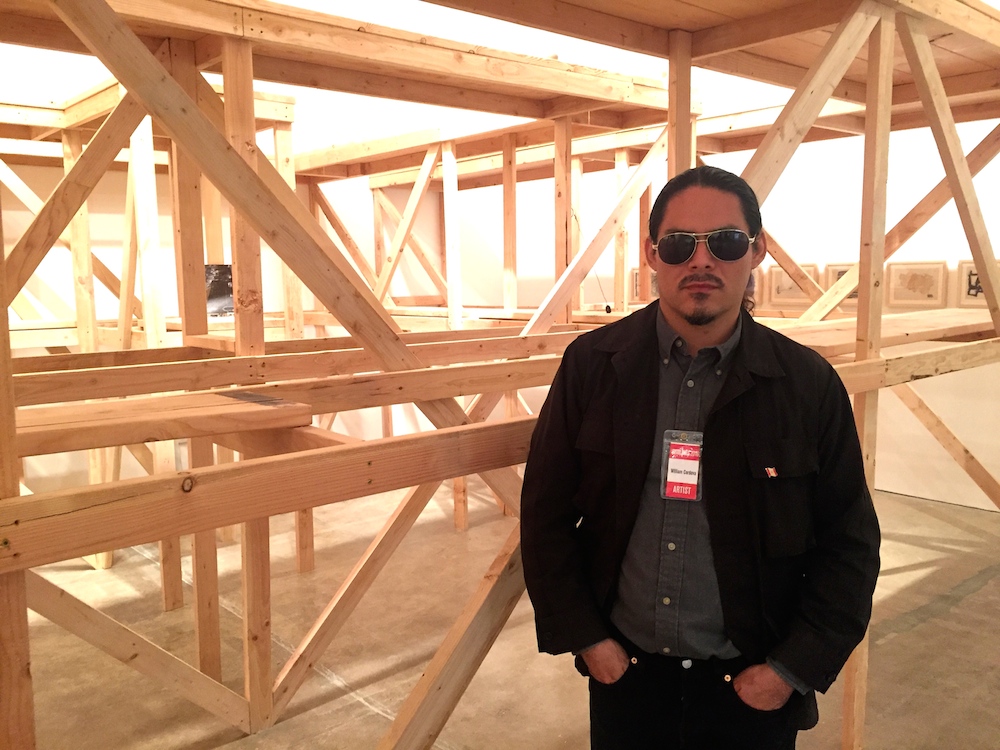
William Cordova. Image: Ben Davis.
9. William Cordova on yawar mallku: sculpting in time (2016)
“The work is a spiral. I was interested in making these connections to time and space and [Frank Lloyd] Wright’s transcendentalist philosophies. And also addressing the sources of those philosophies, which for him are also connected to Asian philosophies, as well as pre-Colombian cultures. I was interested in creating a spiritual space. The spiral is about transformation. The scaffolding is about building. And all these little components inform the narrative that is basically about transcending; that was Wright’s focus—constructing harmoniously with the landscape. So this work is the intersection of all these investigations. And it’s also a labyrinth because you can walk through it.”

Margaret Randall and SITElines co-curator Pablo León de la Barra. Image: Ben Davis.
10. Margaret Randall on El Corno Emplumado, the 1960s bilingual poetry journal based in Mexico City, whose efforts are remembered in a display
“I’d just like to say how honored I am to be here, and to have El Corno represented here. Sergio [Mondragon] and I began thinking about this magazine in 1961. That’s more than a half-century ago. We were kids, and we believed that the Americas were one, and that the world could be one in poetry, and that poetry would change the world. And we made it for eight-and-a-half years, before it died as a result of the Mexican student movement in 1968. But standing here at SITE, it feels like this vision has come true. It feels like it really did change the world, because it was a precursor of all of these wonderful artists, who all in some way have the same idea and are looking forward, at a time when the world needs this spirit more than ever.”
“Much Wider Than a Line” remains on view at SITE Santa Fe through January 8, 2017.